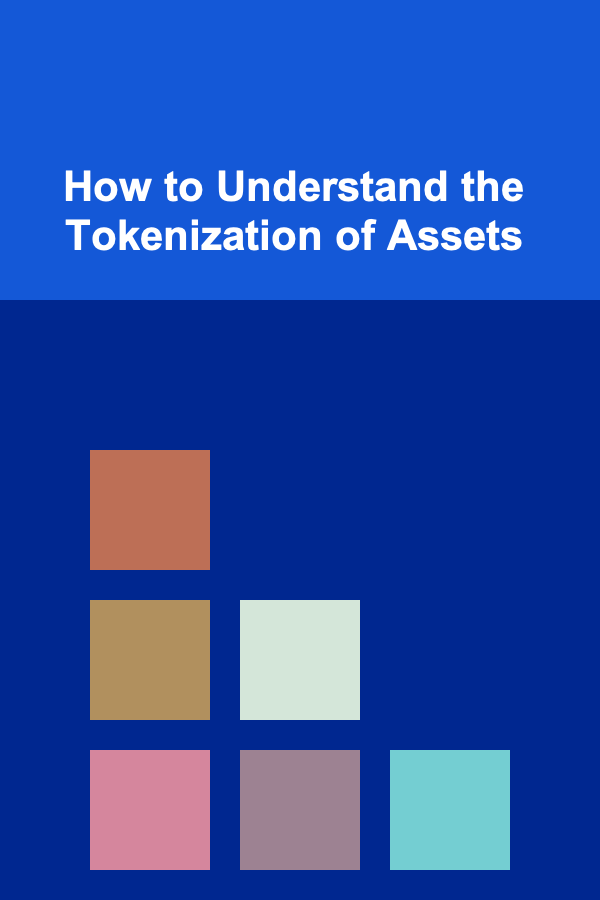
How to Understand the Tokenization of Assets
ebook include PDF & Audio bundle (Micro Guide)
$12.99$9.99
Limited Time Offer! Order within the next:

The tokenization of assets represents one of the most exciting and revolutionary advancements in the world of finance and digital technology. As we transition into an increasingly digital world, the concept of tokenization is becoming a central component in reshaping traditional financial systems. It holds the potential to make a vast range of physical and digital assets more accessible, tradable, and liquid. But how does it work? What are the benefits? And what challenges and risks are associated with it?
In this article, we will explore the tokenization of assets in depth, including its principles, the various asset classes that can be tokenized, the technologies involved, and the potential implications for individuals, businesses, and the global economy.
What Is Tokenization?
Tokenization refers to the process of converting ownership of an asset into a digital token that can be traded, transferred, or stored on a blockchain. Essentially, it involves creating a digital representation of an asset, whether that asset is a physical item like real estate, art, or commodities, or a digital asset such as intellectual property or financial instruments like stocks and bonds.
A tokenized asset represents a specific portion of ownership of the underlying asset. For example, if a real estate property is tokenized, each token represents a fraction of the ownership in that property. Tokenization, thus, allows for fractional ownership, where people can buy and sell small portions of assets that were traditionally illiquid or difficult to divide.
Key Characteristics of Tokenized Assets:
- Digital Representation: Tokenization converts the ownership of an asset into a digital token, often using blockchain technology to ensure transparency, security, and immutability.
- Ownership and Transferability: Tokenized assets allow for fractional ownership, making it easier to transfer and trade portions of assets in a secure and efficient manner.
- Transparency and Security: Blockchain ensures that the ownership and transaction history of the tokenized asset are transparent and secure, reducing the risk of fraud.
- Fractionalization: Tokenization enables fractional ownership, meaning that a single asset can be divided into smaller units that can be traded separately.
How Tokenization Works
To understand tokenization, we need to consider both the traditional and modern ways of dealing with assets.
Traditional Asset Ownership
In the traditional financial system, assets are owned by individuals, companies, or institutions. These ownership rights are represented by physical documents (like deeds, certificates of ownership, or stock certificates), and the process of transferring ownership typically involves intermediaries, such as banks, brokers, or legal institutions. Ownership is often centralized, and it may take time for transactions to be completed, particularly when assets are illiquid.
Blockchain and Smart Contracts
The key technology behind tokenization is blockchain. Blockchain is a decentralized and distributed ledger that allows for secure, transparent, and tamper-proof records of transactions. It enables peer-to-peer transactions without the need for intermediaries.
In the context of tokenization, blockchain facilitates the creation of a digital token that represents ownership of an asset. The token is stored on the blockchain, and every transaction related to the asset is recorded in an immutable ledger.
A crucial component of tokenization is smart contracts. These are self-executing contracts with the terms of the agreement directly written into lines of code. Smart contracts automatically execute the terms of an agreement when certain conditions are met, reducing the need for intermediaries and providing an extra layer of automation and security.
The process of tokenizing an asset generally involves the following steps:
- Selection of the Asset: The first step is determining which asset to tokenize. This could be anything from real estate and art to commodities or even intellectual property.
- Creation of Tokens: Once the asset is selected, digital tokens are created to represent fractions of the asset's ownership. These tokens are typically based on blockchain platforms like Ethereum, which support token standards like ERC-20 or ERC-721.
- Legal Framework: A legal framework is established to ensure that the ownership of the token is backed by real-world ownership of the asset. This may involve creating legal contracts or agreements that tie the token to the underlying asset.
- Issuance and Distribution of Tokens: Tokens are issued to investors or buyers. These tokens can then be traded, bought, or sold on blockchain-based marketplaces.
- Ongoing Management: Ownership, rights, and the transfer of tokens are managed through blockchain-based systems and smart contracts, ensuring that all transactions are transparent and secure.
Types of Tokenized Assets
Not all assets are created equal, and the types of assets that can be tokenized vary widely. The flexibility of tokenization means that nearly any type of asset, whether physical or digital, can be broken down into smaller portions for easier trade and ownership. Below, we explore the main categories of tokenized assets:
1. Real Estate
One of the most promising areas for tokenization is real estate. Real estate is a traditionally illiquid asset, and buying or selling property often involves a complex and slow process. Tokenization can dramatically streamline this process by enabling fractional ownership, making it easier for individuals to invest in properties without having to purchase the entire property.
For example, tokenized real estate allows people to buy and sell portions of properties, such as apartments or commercial buildings, without the need for intermediaries. This also opens up opportunities for smaller investors to participate in high-value real estate markets.
2. Art and Collectibles
The art market is another area where tokenization has gained significant attention. High-value artworks are often difficult to trade due to the high costs involved, the illiquid nature of the market, and the lack of transparency. By tokenizing artwork, ownership can be fractioned, making it easier to invest in valuable pieces without purchasing the entire artwork.
Tokenization also enables greater transparency in the art market, as all transactions and ownership transfers are recorded on the blockchain. This reduces the risk of fraud and makes provenance tracking more accessible.
3. Commodities
Tokenizing commodities like gold, silver, and oil can make these assets more accessible and easier to trade. Investors can buy small portions of these commodities, which have traditionally been difficult to trade in small quantities. This approach also makes commodity trading more efficient, as transactions can occur in real-time and be recorded on the blockchain.
4. Intellectual Property
Intellectual property (IP) rights, such as patents, trademarks, and copyrights, can also be tokenized. Tokenization allows creators to license or sell portions of their IP, enabling easier monetization and fractionalized ownership of valuable digital assets.
5. Financial Instruments
Traditional financial instruments, such as stocks, bonds, and other securities, can be tokenized to provide greater liquidity and lower transaction costs. Security tokens are a specific type of tokenized financial instrument that represents ownership in an underlying asset, such as equity or debt. These tokens can be traded on blockchain-based exchanges, making the trading of stocks and bonds more efficient and accessible.
6. Other Assets
Nearly any type of asset, including luxury goods, sports franchises, or even personal items like rare collectibles, can be tokenized. Tokenization enables fractional ownership and liquidity in markets that traditionally have been inaccessible or illiquid.
Benefits of Tokenization
Tokenization offers a wide range of benefits, making it an appealing option for both investors and businesses. Here are some of the primary advantages of tokenizing assets:
1. Liquidity
Tokenization provides liquidity to previously illiquid markets. Fractional ownership allows individuals to buy and sell portions of an asset, creating greater market depth and enabling more frequent transactions.
2. Lower Costs
By removing intermediaries and leveraging blockchain technology, tokenization reduces transaction costs. Smart contracts automate many processes, eliminating the need for lawyers, brokers, and other intermediaries.
3. Accessibility
Tokenization democratizes access to assets that were previously reserved for high-net-worth individuals or institutions. By fractionalizing assets, individuals can invest in a wide range of assets, including real estate and art, with a relatively small investment.
4. Transparency and Security
Blockchain technology ensures that all transactions related to tokenized assets are secure, transparent, and tamper-proof. The decentralized nature of blockchain reduces the risk of fraud and ensures that all parties can trust the system.
5. Global Reach
Tokenization removes geographical barriers, allowing assets to be bought and sold across borders. Blockchain networks operate globally, which opens up new investment opportunities for individuals and institutions worldwide.
Challenges and Risks
Despite its benefits, tokenization also comes with challenges and risks that need to be considered:
1. Regulatory Uncertainty
One of the main challenges facing tokenization is the lack of clear regulatory frameworks. Governments and regulatory bodies are still figuring out how to regulate tokenized assets, especially security tokens, which blur the lines between traditional assets and digital representations. Regulatory uncertainty can create legal risks for both issuers and investors.
2. Legal and Operational Challenges
Tokenizing real-world assets requires a complex legal and operational framework to ensure that the ownership of the token corresponds to the underlying asset. Issues such as intellectual property rights, property laws, and cross-border jurisdictional challenges can complicate the tokenization process.
3. Technology Risks
Blockchain technology, while secure, is still evolving. The risk of hacking, vulnerabilities in smart contracts, and network failures can jeopardize the security of tokenized assets. Additionally, blockchain platforms may be subject to scalability issues or delays in transaction processing.
4. Market Volatility
Tokenized assets, particularly those tied to cryptocurrencies or digital markets, may be subject to higher levels of volatility than traditional assets. The prices of these assets can fluctuate rapidly, making them a risky investment for some investors.
Conclusion
Tokenization of assets represents a paradigm shift in how we think about ownership, investment, and trade. By using blockchain technology to digitize and fractionalize ownership of assets, tokenization enables greater liquidity, accessibility, and efficiency in markets that were previously inaccessible or inefficient.
However, as with any innovation, tokenization comes with its own set of challenges, including regulatory uncertainty, legal complexities, and technology risks. Despite these obstacles, the potential benefits of tokenizing assets are significant, and we are likely to see continued growth and adoption of this technology in the coming years. As the world becomes more digital and decentralized, tokenization will play an increasingly important role in transforming the global economy.

How to Cultivate Equanimity in All Situations
Read More
How to Freshen Up Your Home with DIY Air Fresheners
Read More
How to Make Your Own Healthy Baked Goods
Read More
How To Collect Data Using Remotely Sensed Imagery
Read More
How To Choose the Right Lens for Every Shot
Read More
How To Discover Your Next Favorite Indie Artist
Read MoreOther Products

How to Cultivate Equanimity in All Situations
Read More
How to Freshen Up Your Home with DIY Air Fresheners
Read More
How to Make Your Own Healthy Baked Goods
Read More
How To Collect Data Using Remotely Sensed Imagery
Read More
How To Choose the Right Lens for Every Shot
Read More